Welcome to our blog for the Plastic in the Pacific Crusade. If you missed the earlier editions please use the category search in the footer to go back and read them. They are listed under Plastic in the Pacific. Over the coming year we will be writing regularly of our adventures and what we are seeing. In this article we write about our trip from Almerimar to Canary Islands.
In our last edition we had just departed Almerimar Spain en-route to the Canary Islands. We had waited for a weather window having had a week of westerlies so when the easterlies hit, it was time to go. All advice had it that we should get to the straits of Gibraltar as soon as we could as you don’t want big weather through that part of the world. So I had already made a mental note to keep the speeds up, even if it meant running the engine, at least until we got through the straits.
So when an hour out from Almerimar, the temperature alarm goes off on the engine, it’s a bit disconcerting. After a quick check it was found that the fresh water cooling system had once again dropped into the bilge courtesy of one of these plugs on the engines. It had a small hole and all the water under pressure had dropped out. We had purchased some liquid steel and whilst Annika was adamant we should turn around, I was confident we could repair it. So we continued sailing on as the engine cooled and made a repair which turned out to be successful.
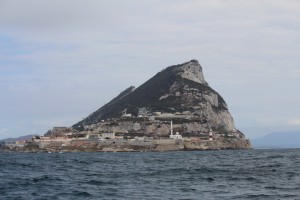 It is about 140nm from Almerimar to Gibraltar so about 24 hours. We wanted a transit during daylight hours and with as little tide as possible so we had timed everything, that was until the currents were a lot stronger than expected and the wind a lot lighter than expected. So we had no choice but to motor however we were still only doing 3.5 knots at times. In the morning the wind was totally gone and I saw a tide line and managed to sit on the edge of it. It increased our speed back up to 5 knots and the Rock of Gibraltar came into view. There were a lot of ships anchored under the rock which we thought could have been waiting to go through the straits. Later we found out they were actually going into Gibraltar. There were a lot of dolphins and even pilot whales sighted with the currents drawing in lots of food because of the nutrients at the joining of the two seas.
It is about 140nm from Almerimar to Gibraltar so about 24 hours. We wanted a transit during daylight hours and with as little tide as possible so we had timed everything, that was until the currents were a lot stronger than expected and the wind a lot lighter than expected. So we had no choice but to motor however we were still only doing 3.5 knots at times. In the morning the wind was totally gone and I saw a tide line and managed to sit on the edge of it. It increased our speed back up to 5 knots and the Rock of Gibraltar came into view. There were a lot of ships anchored under the rock which we thought could have been waiting to go through the straits. Later we found out they were actually going into Gibraltar. There were a lot of dolphins and even pilot whales sighted with the currents drawing in lots of food because of the nutrients at the joining of the two seas.
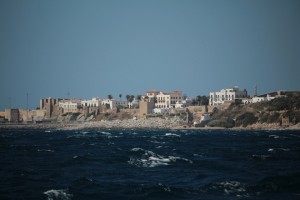 So we enter the straits of Gibraltar in a glass out. We picked up the reverse eddy running along the north shore. We knew when we were in it and when we were out of it by our speed over ground. It would vary 2 knots. The wind started to build about half way through the strait and we launched the mainsail. It kept building and before we knew it we had to reef it down. By the time we hit the western end of Gibraltar, a very pretty township (Tarifa) I must say and definitely a place to visit in the future, the wind was howling through at 30 knots. We had a small amount of main out and started surfing along at 11 knots with a bit of current pushing us along as well. Plenty of shipping traffic was evident however we were right along the northern shoreline, well out of their way. However we did have to transit to the south at some stage.
So we enter the straits of Gibraltar in a glass out. We picked up the reverse eddy running along the north shore. We knew when we were in it and when we were out of it by our speed over ground. It would vary 2 knots. The wind started to build about half way through the strait and we launched the mainsail. It kept building and before we knew it we had to reef it down. By the time we hit the western end of Gibraltar, a very pretty township (Tarifa) I must say and definitely a place to visit in the future, the wind was howling through at 30 knots. We had a small amount of main out and started surfing along at 11 knots with a bit of current pushing us along as well. Plenty of shipping traffic was evident however we were right along the northern shoreline, well out of their way. However we did have to transit to the south at some stage.
We decided to gybe when we knew we could clear the North-West coast of Africa and wanted to achieve the crossing of the channel after the traffic separation scheme and during daylight so ships knew the lights were from a sailing vessel. We only had one close call where ships got within one nautical mile either side of us. We slipped between the two without having to change course, however I am sure the ships did move a few degrees. We settled in with still about half the main firing us along and as the sun set we were in the Atlantic Ocean, clear of the Mediterranean Sea, a sea that I will remember for being one of the dirtiest bodies of water I’ve ever sailed in.
During the evening the wind slowly abated and we increased sail more and more to keep our speeds up. By 0900 we actually had a glass out. Our routing had meant we had gone west quite a bit to try and get around an area of low wind closer to the coast and as we downloaded the new forecast it showed we actually had to go further west. The next 24 hours would prove very frustrating as we had very little wind. The forecast was wrong, that’s the only way to put it. Finally at 0900 the following day we had 10-15 so we got ‘Sunny’ (Our spinnaker) out. On trying to launch it the spinnaker halyard stripped its casing and basically got stuck at the sheave coming out of the mast so it wouldn’t go up or come down. Lucky our spinnaker is in a sock as it was still under control. Had it launched then it would have been a major issue. Annika hates going up the mast at the best of times but out in the middle of the ocean, it is best I get her up and down quickly, rather than climb it slowly myself. She was really nervous with the boat rolling around in the swells as I pumped her up the rig with Siv tailing the rope. We got her ¾’s the way up where she could disconnect the spinnaker and drop it to deck. Then she stitched a mouse line on the old halyard and we were able to feed it back to deck. We then dropped her to the deck, much to her relief.
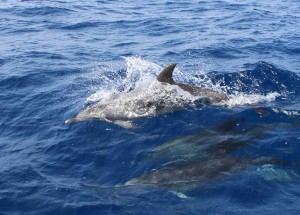 It would take me a couple of hours to whip the casing on the halyard so that we could reuse the same halyard again. We swapped it end for end and by 1200 we were under spinnaker once again. We had chosen to sail down the coast as there was a wind band there, whilst the area of light wind had extended further west meaning we’d have to motor 200nm west to get to any decent wind. It was another light wind day and the following day we had a bit of wind in the morning and nothing all afternoon before it filled in again in the evening. The breeze would last all night and we had dolphins on the bow for a lot of the time. It was awesome to sit back and watch Siv with the dolphins. She was alike a little girl, so excited and the smile remained on her face long after the dolphins had gone. This is the only way to see dolphins, not in captivity where they are drugged and performing tricks, seeing them in the wild where they can do as they please is a magic moment.
It would take me a couple of hours to whip the casing on the halyard so that we could reuse the same halyard again. We swapped it end for end and by 1200 we were under spinnaker once again. We had chosen to sail down the coast as there was a wind band there, whilst the area of light wind had extended further west meaning we’d have to motor 200nm west to get to any decent wind. It was another light wind day and the following day we had a bit of wind in the morning and nothing all afternoon before it filled in again in the evening. The breeze would last all night and we had dolphins on the bow for a lot of the time. It was awesome to sit back and watch Siv with the dolphins. She was alike a little girl, so excited and the smile remained on her face long after the dolphins had gone. This is the only way to see dolphins, not in captivity where they are drugged and performing tricks, seeing them in the wild where they can do as they please is a magic moment.
24 hours out of Lanzarote it would turn light once again so we motored a lot, way too much for our liking but we weren’t going to sit out and roll around in the light air when we had to get Siv to a flight so she could get home. At 0115 on the 24th September we would put anchor down at Muelle De La Pescaderia in Lanzarote. It was inside a rock wall and was a perfect little anchorage. It was good to stop, not because we don’t like sailing, but because we had motored way too much for our liking and it was good to be at our destination.
In the morning we went down to Puerto Calero where we were to meet the man to give him a bottle of wine. Steaming along the coast it became very obvious that you could paint your house any color, as long as it was white. Yes every private house on Lanzarote is white. Most hotels are the same. It was rare to find a colored building. The beaches were covered in tourists and you could see the place was a huge tourist destination. The water color was spectacular blue and as we motored around the rocks into the marina, we could easily see the bottom 10m down. We pulled up on the fuel wharf and took on 166 liters of diesel, we had steamed a lot over the last week. We filled up with water and washed the boat down. Annika had the fuel attendant guy call our wine guy and he came down just before lunch. It was awesome to talk to him and he was so happy to have been given a gift delivered across the seas.
We decided to lash out and go to a sushi bar for lunch to get some internet to organise Siv’s flight home which would be a couple of days later out of Las Palmas, Gran Canaria. At 1700 we departed Puerto Calero and moved to the southern end of the island. The landscape was stunning. It is so barren, almost like a moonscape. No green at all, just volcanic rock against a crystal clear sea. Around the western point was an amazing beach of white sand. I have seen some amazing places in my life including Mt Haleakala on Maui, Hawaii which is like the moon, but to see this at sea level, with beaches, was something else.
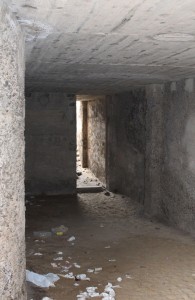 In the morning we went for a walk on land. It seems that the thing to do is to move rocks around into a love heart with your initials so of course, being on our honeymoon of sorts, we did that. We walked around the cliffs and found an old dugout which tourist have been using as a rubbish tip it seems. It was really disgusting to see that humans could deface a beautiful place like this but we are a ‘different’ generation it seems, we still think people will clean up after ourselves. Crossing back over the beach and it seems there are a lot of ‘poor’ young ladies that can only afford half a bikini!!!
In the morning we went for a walk on land. It seems that the thing to do is to move rocks around into a love heart with your initials so of course, being on our honeymoon of sorts, we did that. We walked around the cliffs and found an old dugout which tourist have been using as a rubbish tip it seems. It was really disgusting to see that humans could deface a beautiful place like this but we are a ‘different’ generation it seems, we still think people will clean up after ourselves. Crossing back over the beach and it seems there are a lot of ‘poor’ young ladies that can only afford half a bikini!!!
Back on the boat and we decided to go for a snorkel as the cliff faces looked interesting. There was nothing to see mind you, apart from a bit of rubbish and the odd fish, but it was nice to get wet. After lunch we packed the boat away and set off at 1500 for Las Palmas, an overnight sail of 85nm. Leaving the anchorage we had a great wind so set the spinnaker and it looked like we’d sail straight there but then Fuerteventura got in the way and the wind died. We steamed clear of the island and then the breeze filled in again allowing us to launch the kite. We would sail with it all the way across the passage, a rare time we would sail with ‘sunny’ up at night.
We arrived at Las Palmas at 0650 and anchored between the two marinas. They only open this area around the this time with all the boat arriving for the ARC (Atlantic Rally Crossing) but they charge you to anchor which is crazy. Las Palmas is built inside a massive port and the smell from the working docks was very strong. In the early light we could see people working out on the beach and then the sound of traffic. The place is not as I had imagined after Lanzarote. This is a big city. The water color was horrible and not a place we wanted to make water with our water maker. The worst part about our location was that it was right near the hospital and that means all day and night you hear ambulances. We had gone into Las Palmas as it is the set off point for the ARC. We didn’t want to join the ARC but we had hoped to get a couple of people to sail with us across the Atlantic and contribute to our costs as our funds were running low.
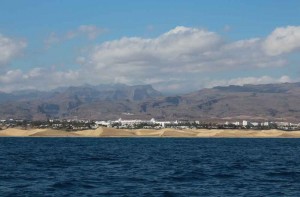 We met up with a Slovakian lady called Zuzana who had expressed an interest in sailing across. She had no sailing experience but seemed passionate to learn. Her English was not too good but she and Annika got along so we agreed to take her. Siv had completed her journey and flew home and we did a bit of shopping that afternoon. The next day Zuzana moved onto the boat, we got final provisions and on the 30th we set off down south to see how Zuzana would go in swells and to find a nicer part of the island. Sailing around the south eastern point and there is a huge sand dune near the tourist area. It is so different to the rest of the island which is once again quite barren. We tried one anchorage but it was too rough so continued further around the island to a place called Puerto De Anti Del Mar. It is a tourist destination too with massive hotels bordering the whole waterfront. We found a nice anchorage and relaxed for the afternoon and evening.
We met up with a Slovakian lady called Zuzana who had expressed an interest in sailing across. She had no sailing experience but seemed passionate to learn. Her English was not too good but she and Annika got along so we agreed to take her. Siv had completed her journey and flew home and we did a bit of shopping that afternoon. The next day Zuzana moved onto the boat, we got final provisions and on the 30th we set off down south to see how Zuzana would go in swells and to find a nicer part of the island. Sailing around the south eastern point and there is a huge sand dune near the tourist area. It is so different to the rest of the island which is once again quite barren. We tried one anchorage but it was too rough so continued further around the island to a place called Puerto De Anti Del Mar. It is a tourist destination too with massive hotels bordering the whole waterfront. We found a nice anchorage and relaxed for the afternoon and evening.
 The next day we did a bit of work on the boat and then explored the mainland before another relaxing evening on the yacht. The following day we moved around to Puerto de Mogan which we had seen was a classic little town and we arrived on market day to find thousands of people walking the street surrounding the marina. But the town was very pretty and once the crowds dispersed it was so nice. We stayed a couple of nights and stocked up for our crossing. All the time we were getting to know Zuzana and trying to make sure she understood what she was in for. We hoped for a crossing under three weeks, we weren’t racing, it was about getting there safely. Did someone who had only sailed a few crossing between islands have any idea what 21 days at sea would be like? Annika’s longest stint at sea was 11 days, so it was a long time for her too, but we’d been living on the boat for 2 months. We had no choice in the end, we needed the financial help so on the 3rd October at 1140 we departed the Canary Islands for our Atlantic Crossing.
The next day we did a bit of work on the boat and then explored the mainland before another relaxing evening on the yacht. The following day we moved around to Puerto de Mogan which we had seen was a classic little town and we arrived on market day to find thousands of people walking the street surrounding the marina. But the town was very pretty and once the crowds dispersed it was so nice. We stayed a couple of nights and stocked up for our crossing. All the time we were getting to know Zuzana and trying to make sure she understood what she was in for. We hoped for a crossing under three weeks, we weren’t racing, it was about getting there safely. Did someone who had only sailed a few crossing between islands have any idea what 21 days at sea would be like? Annika’s longest stint at sea was 11 days, so it was a long time for her too, but we’d been living on the boat for 2 months. We had no choice in the end, we needed the financial help so on the 3rd October at 1140 we departed the Canary Islands for our Atlantic Crossing.
How long would it take? Were the conditions going to favour us? Would we catch fish? How would our non-sailor take the isolation? So many questions to answer for our first Atlantic Crossing. One thing we knew was that at the other end was Barbados, home of our favorite Rum, Mount Gay.
In our next edition we take on the Atlantic Ocean, 2600nm non-stop as the bird flies.
Ocean Crusaders are out to change the way people treat our oceans. Our online education program is free to download at www.OceanCrusaders.org/education where children can learn of the issues our oceans are facing and how they can make a difference. The Plastic in the Pacific Crusade is about educating the South Pacific Islands, finding out what is happening in these islands and updating our programs. You can join us in the Pacific and see for yourself what we do.
Ocean Crusaders Plastic in the Pacific Crusade is proudly supported by: Cressi Dive Gear, Gill Marine, Keen Footwear Australia, Barz Optics Sunglasses, Maxsea Navigation Software, Digital Diver Cairns, LED Dive Lights Australia, Boat Names Australia & Predictwind Weather
[cincopa AECAWGdbo8yH]